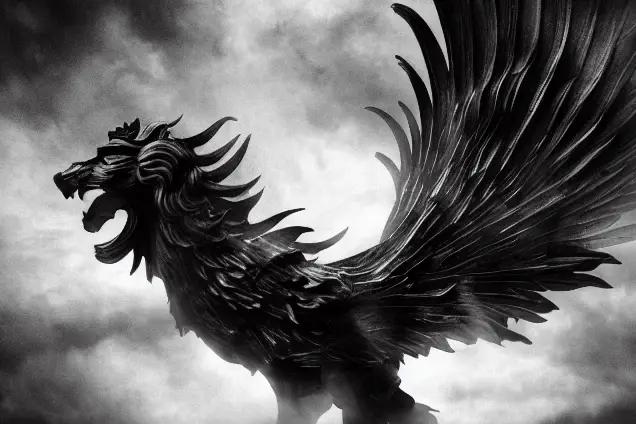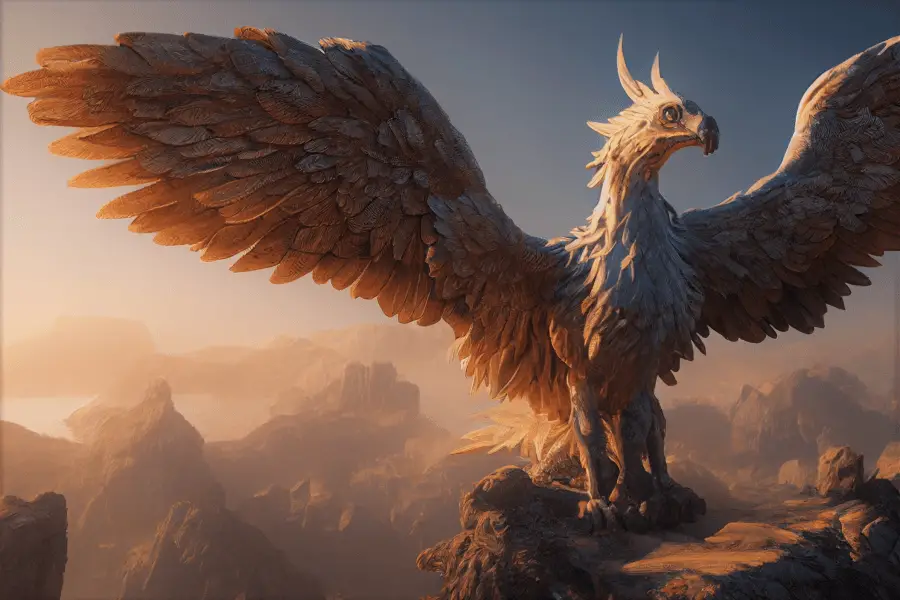Share the Lore!
By: Alex Postrado
Griffins: The Mythical, Bird-Like Treasure Keepers Of Greek Mythology
Birds take on salient roles in countless myths and legends. Often, as messengers of the gods, and other times, as either tricksters or ancient gatekeepers 一 they symbolize a wide range of concepts that commonly include fertility, wisdom, life, death, rebirth, misfortune, and divine power.
But, in Greek mythology, there is a species of chimerical bird that embodies things that are apart from the ones previously mentioned 一 instead representing nobility, courage, fierceness, and vigilance.
They are known as griffins.
WHAT ARE GRIFFINS?
At the center of composite mythical creatures from Greek mythology that soar through the air and walk the lands, stand the mighty griffins.
Described as beings “with the melded attributes of a lion and an eagle,” griffins commanded a deep sense of respect among those who knew of their tale.

And why wouldn’t they? After all, the same way as the lion is often dubbed “the king of the beasts,” the eagle is considered “the king of the air.”
And combined, these two signify majesty, regality, and divinity 一 among other things.
Traditionally, the larger part of griffins’ bodies is specifically said to be that of a lion 一 with only their heads resembling that of an eagle.
But later depictions had them shown as monsters with the body, tail, and hind legs of a lion, and the head, forelegs, and talons of an eagle.
While winged griffins are found in many stories, wingless ones also frequently make appearances in art and literature.
And throughout retellings, they tend to be partly covered in fur and partly feathered.
But it is when it comes to their color and coat pattern that records become widely contradictory.
2nd century AD Greek geographer and navigator, Pausanias, claimed that the bird-like beasts “had spots like a leopard.”
Roman author Claudius Aelianus, commonly known as Aelian, on the other hand, noted in his work, De Natura Animalium, or On the Characteristics of Animals, that griffins are even more flamboyant in form 一 having a neck that is “variegated with feathers of a dark shade of blue,” and white wings that are feathered red in front and black at the back.
Despite the dissimilarities, most people stick to the idea that griffins’ are actually brownish in color.
Just the same as they hold that griffins are the ancient world’s guardians of treasures and other priceless possessions.
MYTHICAL KEEPERS OF TREASURES
Greek and Roman texts must have taken inspiration from the dragon lore when they recorded the mythology of griffins.
In most chronicles, the often-described wily griffins are “associated with gold deposits,” as in the writings of Roman author and philosopher Pliny the Elder, quoted “griffins were said to lay eggs in burrows on the ground and these nests contained gold nuggets.”
This cunning yet protective function of griffins establishes the very reason why, in both art and stories, they typically appear in sacred tomb furnishings.
On the flip side, the griffin’s frequent pairing with the sphinx 一 which, as we know, is a winged woman-headed riddler 一 is a testament to the bird beast’s trickster nature, that is to say, for every right riddle answer, treasures are given and lives are spared.
Particularly, in Greek mythology 一 where the earliest references to the lion-eagle hybrid can be found 一 griffins are alternatively called “The Hounds of Zeus.”
They are creatures tasked to look after the gold and riches in the mountains of Scythia. And they dwell in the nearby Rhipaean mountains 一 at the foot of which live their unfriendly, one-eyed neighbors, the Arimaspians.
The Arimaspians have a long history of feuding with the griffins, which started when they attempted to steal the gold deposits the mountain-dwelling griffins were entrusted to guard.
This bitter, ongoing quarrel between the two races of monsters also led to the “hostility between the horse and the griffin” 一 a result of the Arimaspians, often attacking horseback.
Proof of this lies in a line from Aeschylus’s ancient Greek tragedy, Prometheus Bound, which says:
“Keep watching out for gryphons, hounds of Zeus, who have sharp beaks and never bark out loud, and for that one-eyed Arimaspian horde on horseback, who live beside the flow of Pluto’s gold-rich stream. Do not go near them.”
WAS IT GRIFFIN OR GRYPHON?
Most of us might be familiar with the term griffin, but other variations of the name also appear in texts 一 with gryphon, perhaps, being the next most popular among the bunch.
Both griffin and gryphon derive from the Greek word grypos, which means “hooked” or “curved“.
And with that, the ancient Greek term grū́ps comes to light, literally translating to “curved or hooked nose” 一 a reference to the bird monster’s beak.
Moreover, the name griffin may also be spelled gryphoi, gryphis, griffon, or grifon 一 which, in Old French, pertains to both the legendary lion-eagle, as well as birds of prey, in general.
HISTORY AND ORIGIN of GRIFFINS
Till today, scholars argue about the exact origins of the mythology of the griffins.
Although the earliest written records come from the 7th century BCE, visual depictions of the typically-winged monster can be traced centuries prior 一 as it happens, in a wide array of cultures that include European, Anatolian, Egyptian, Iranian, Mediterranean, and Indian.
Even so, griffins already existed in art pieces from Greece and the western part of Asia since the 14th century BCE. And the bird-like beast’s popularity in these areas peaked once again during the Iron Age when metalworkers frequently portrayed griffins in their creations using a unique art style that accented the griffin’s wide open beak and coiled tongue.
MEDIEVAL REBIRTH
When the Middle Ages came, griffins earned some kind of revival through their depiction in medieval bestiaries and 一 more importantly 一 heraldry.
They appeared, not only as decorative icons on coats of arms and similar armorial bearings of the royal and noble families but also as an emblem of the Christian church.
According to legends, griffins mated for life. And should either partner die, the other would “continue the rest of its life alone, never to search for a new mate.”
The church saw this particular detail of the griffin lore as a symbol of marital fidelity 一 mirroring the Bible’s absolute opposition to divorce as well as remarriage.
Moreover, the mythical creature’s distinct composition as “a union of an aerial bird and a terrestrial beast” made it ineluctable for the church to see griffins in the light of Christ 一 divine and human, both at once.
Thus, griffin sculptures frequently adorned Christian kirks.
In bestiaries, a griffin’s claw, egg, or feather were sketched as oddities that have certain medicinal properties 一 one of which is said to be the ability to heal the blind.
Goblets and other items were often fashioned after these griffin relics and were “highly prized” in most medieval courts.

CULTURAL COUNTERPARTS
Apart from griffins, ancient mythologies from a variety of cultures also tell of fantastical creatures that resemble the bird-like beast of Greece.
In ancient Egypt, for instance, instead of a lion-eagle meld, there were falcon-headed, feline-bodied monsters that parallel the griffins.
In Crete, there was the Minoan Genius 一 a part-bird creature that had the head of either a lion or a hippopotamus.
Iranian myths describe the fabled existence of Shirdal 一 a name that literally translates to “lion-eagle”.
And the Assyrians believed in the Lamassu, which was a protective deity that, according to stories, had the wings of an eagle, a lion or a bull’s body, and the head of a human.
FROM ANCIENT SYMBOLISMS TO MODERN RELEVANCE
It is no secret that, in the ancient world, Greek mythology’s griffin boasts huge influence, as well as relevance, to different cultures.
First introduced as the trustworthy yet guileful keepers of the Scythian gold, they eventually evolved into the Dark Ages’ symbol of watchfulness, wisdom, boldness, and strength, before ultimately finding their way into modern-day prominence.
And now, owing to their combined qualities of both the lion and the eagle, we watch griffins consistently get represented in popular culture 一 in fantasy-based books and games, the likes of The Spiderwick Chronicles and Dungeons & Dragons.
All of which, perhaps, makes one thing clear:
That both the myth and the monster 一 the legendary Hounds of Zeus 一 are, more or less, just as prized as the treasures they guard.
References:
Griffin - Mythological Creature Griffin (Gryphs) - Theoi Project Mythical Beasts: The Griffin, The Legendary King Of All Creatures Griffin - Mythology Mythology Of The Griffin Griffin - Myths And Folklore What Was The Griffin? – History And Symbolism
